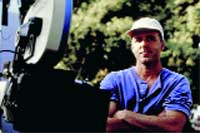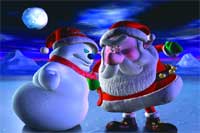
Filmmaker Steve Oedekerk's holiday special brings 3D animation to the biggest screen
|
With the completion of Santa vs. the Snowman, filmmaker Steve Oedekerk realized a long-time dream, one that brings family entertainment to the big screen in a way never before achieved. This 35-minute, multichannel IMAX feature is entirely computer generated, and when viewed with IMAX's polarized or electronic glasses, provides an incredibly immersive 3D experience.
Oedekerk worked with DNA Productions (www.dnahelix.com) and his own San Clemente, CA-based Omation/O Digital facility to create the animated holiday film, which features the voices of Jonathan Winters, Ben Stein and Victoria Jackson. Post had a chance to chat with him as Santa vs. the Snowman geared up for its November release. Here's what he had to say about the IMAX filmmaking process, working in 3D, and doing it all with just a modest $10 million budget.
Post: What inspired you to create this IMAX 3D project?
Oedekerk: This literally flashes back to me as a kid, watching a documentary in an IMAX theater. I've always loved being in a theater and at movies and thought, "There should be a regular movie in here." So it's been a 25-year-old thought of mine. The animation seems to fit and the story seems to fit, so I ear-marked [Santa vs. the Snowman] a few years ago. When I saw the footage the first time I said, "Holy smokes! This is like watching a movie in the future."
Post: The budget was $10 million? How does that stack up when creating a large format project?

The 35-minute Santa vs. the Snowman represents Steve Oedekerk's vision of bringing family entertainment to IMAX venues.
|
Oedekerk: We had to muscle this thing through; it was equivalent to making an independent film. It was difficult to get it made for the high bar of quality we were trying to achieve and with the amount of money we had.
Post: So it was really a personal interest that inspired you?
Oedekerk: My personal dream is to be a part of the reason that, maybe 10 years from now, families start going to large format theaters. It's such a great environment to have a special movie experience, and I don't think people are associating that with these theaters today.
Post: Were you a fan of those stop-motion Christmas specials?
Oedekerk: We've all been watching Berle Ives and Fred Astair, and it hit me: "Why isn't anyone making Christmas specials anymore?" I thought there should be an updated one, because animation has improved. And a few minutes later the whole story just unfolded in my head. That was four years ago. I thought this would be a perfect one for IMAX and for 3D, but I didn't know how to do it then. I checked into it a little bit and it seemed that it was going to be way too expensive.
Post: Did you research the 3D or IMAX aspects first?
Oedekerk: The first calls I made were to IMAX, because I didn't understand the whole film-out process and how they do their 3D. Hugh Murray, who is a tech guy at IMAX, started walking me through the process in terms of filming out, and he led me to their lab, DKP. I learned how incredibly different this industry is from regular filmmaking, in every way: from a lack of screens to how long it takes just to film something out just to look at it. It's not like you can just freely look at dailies like on a normal movie. A lot if it was flying blind. A lot of what we had to get down was the composition on those screens, which was entirely different. We really had to wrap our heads around how huge that screen was. And you don't have a huge screen in the next room to go and check it on.
Post: Digital cinema servers and projectors aren't an option for IMAX projects?
Oedekerk: [The digital projectors] would make it a dream because they really are huge film frames. There are very few labs that actually do [IMAX prints], and it takes them a very long time to pump out just one print. So it's a slow process. Digital cinema is not an option yet. I know they are messing with it. Also, shooting high def and transferring to 15/70 film - even though it's possible, it doesn't totally hold together yet.
Post: So that fact that you need to work with film must have really impacted the budget?
Oedekerk: It was really difficult. Most people would not be able to pull this off with the numbers we did because you are still producing a film. And you are much more heavily leveraged in terms of the technical aspects in that you have to pay for the lab work and all of that. So we just couldn't go film out all the time. It was really: check a few shots, come up with a rule book, finish the film, and we crossed our fingers when we looked at the final film out.
Post: You worked with animation house DNA Productions on both Santa and the recent film Jimmy Neutron?
Oedekerk: I met them five or six years ago. DNA did the original [Santa] animation, which was framed for a television screen. When we were first making it, I was thinking about just going to TV. So that's how DNA finished the initial framing. Then it went to Omation, which is our own animation company here. We took the LightWave files and my team here went in and made the IMAX version, and backed up the camera. Every time you back up the camera, you are including all of these characters that hadn't been animated. Or you're shooting off the set. You back up and there is no building there. And it had to be done with every single shot. So it was really a great co-venture.
Post: Is LightWave your tool of choice?

NewTek LightWave, running on PCs, was the animation package of choice for DNA and Omation. Footage was rendered at 2K resolution.
|
Oedekerk: For [our next project with Nickelodeon] The Barn Yard, we're going to research it. I always research before every project just to go out and check all of the platforms again. But yeah, as of right now we are thinking LightWave.
Post: Do you have a platform preference?
Oedekerk: PC - all Pentium 4s. The rendering engines are getting better all the time.
Post: Who developed Santa's characters?
Oedekerk: I had the whole story in my head. The lonely snowman, waging war on Santa, and them becoming friends. [Producer] John [Davis] wrote it and then I did a punch up comedy pass on it. It's very collaborative when I work with DNA. Keith Alcorn, who is a co-owner in DNA with John, gets left out all too much. He's a brilliant character designer. All of the characters in Santa and Neutron were all designed by Keith.
Post: How did you develop Santa's musical sequence? Oedekerk: A friend of mine named Vern Nelson wrote that song. He's a local musician and a real talented guy. I went to grade school with him. And that's what was fun about this project - using established talent [along with] new people and fresh talent.
Post: How about the film's sound design?
Oedekerk: We used a guy - Dan Shattuck - who has a local sound facility, so we had him put the sound together on our first pass of sound. For the IMAX version, we went to Master's Workshop in Toronto, because I wanted to go with someone who knew the large-format speaker set-up really well. Master's took all of Dan's elements and incorporated them into new elements that they brought. They did the final mix.
Post: Was it like starting over when you decided to re-create it for IMAX release?
Oedekerk: There were two clear tiers to this project: the "Hey, let's get it done any way that we can" and the "Hey, this has to be an IMAX film." We did a lot of redoing. For every single shot, the cameras would change and a lot of the textures had to change because the resolution had to come up so much.
Post: Were you working with a certain resolution in mind?
Oedekerk: In a perfect world, you would render out at 4K per frame. But much like in live action features, your film frame is 2K but the visual effects that get done in big movies are done in 1K, and then transferred to film at 2K. It was the same formula for Santa - we rendered at 2K and because there are two projectors projecting 2K images, it actually looks higher than 2K. While it's not true, you get the impression you are looking at 4K.
Post: How long was the rendering process?
Oedekerk: The thing that cracks me up about rendering is - I've been into CG animation since the day I could get my hands on it, which was the Amiga computer - and no matter how much time goes by and how good technology gets, we will load in enough shit to make sure that the rendering is horrifyingly long. You'll load in enough plug-ins and reflections so that you have hours and hours of frames. It's always longer than you think.
We had to leave months for the rendering. We would have hard dates, where on regular movies you can cheat because if the sound is going and picture is locked, you can deliver an effects shot up to the last second. But [you can't do that] in IMAX or the large format world because the film outs take so long. You really have to deliver all of the elements in time because it takes them so long to make the prints. They have to have a master print done probably three months before the release, just to be able to make like 50 prints.
Post: How much did the film expense, rendering time and fatigue that comes from wearing 3D glasses influence your decision to make it a 35-minute film?
Oedekerk: Very much so. The TV version that we were working on was just atrociously fast paced. It played fine, but it just wasn't breathing. It ended up being a nice marriage with IMAX. That is the normal running length when you go to look at a documentary or an IMAX film - 40 to 45 minutes. And in 3D, the jury is still out as to how it feels at 80 minutes. There's still never been anything that long. For 3D, I think 35 minutes is better than 45 minutes, where nobody is saying at the end that it was starting to bug their head.
Post: How are you storing Santa's assets?
Oedekerk: That's what we are doing now, and I have a better plan for the future. [O Digital's digital effects supervisor] Dave Merrell is in the process of not only archiving everything digitally, [but of] pulling out every 3D still I might ever want for whatever reason. Then all of that will be archived to hard drive and tape backup. Because I don't really trust [it].
Post: Will Santa eventually be released on DVD?
Oedekerk: The problem when we go to DVD, is it's not framed properly for TV. So Dave Merrell and [graphics artist] Garrett Reese are literally going to be going into the frames at full rez and cropping every shot.